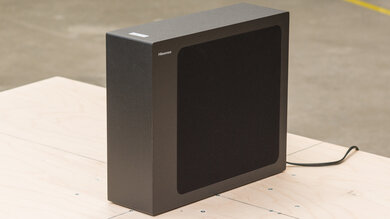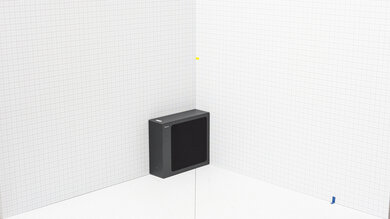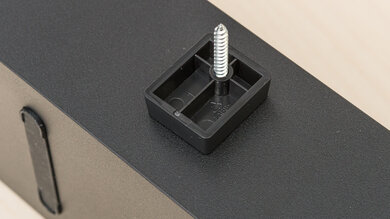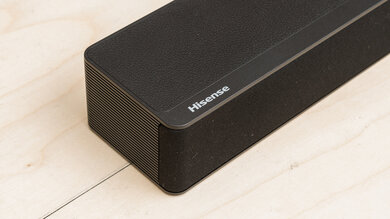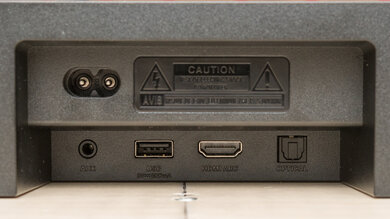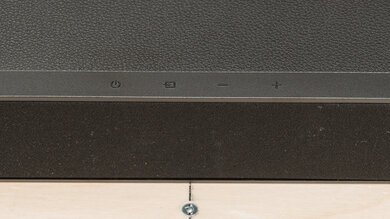The Hisense HS2100 is a wallet-friendly 2.1 soundbar. It's similar in appearance to other Hisense soundbars, like the Hisense HS214, but comes with a wireless subwoofer that adds rumble and punch to your listening experience. While there's no Dolby Atmos compatibility, which is to be expected at this price point, it can play back Dolby Digital and DTS content via its HDMI ARC connection. Its small size means that it'll fit discretely under most TVs, and it comes with an array of sound enhancement features, like EQ presets and virtual surround sound, that help differentiate it from other budget soundbars.
Our Verdict
The Hisense HS2100 is alright for mixed usage. This 2.1 bar downmixes to stereo, which isn't great for an immersive audio experience but won't be an issue for regular stereo content, and its decent soundstage is well-suited to dialogue-driven movies and TV shows. While there's no Dolby Atmos support, there's support for multi-channel formats like DTS and Dolby digital support. Its default sound profile is warm, with a decent amount of bass, thanks to its dedicated sub. That said, even with the sub, there's not a lot of low-frequency extension. On the upside, there are plenty of sound enhancement features, like EQ presets and a virtual surround feature, that can help you tailor the sound to your liking.
-
Onboard bass/treble adjustment.
-
EQ presets available.
-
Downmixes surround sound content.
-
Some compression at max volume.
The Hisense HS2100 is good for dialogue and TV shows. It gets loud enough to fill your living room, although there are some compression artifacts present at max volume. The default sound profile is also well-suited to this type of content. It's a little warm, but the balanced mids and highs mean that dialogue and speech are reproduced clearly. You can also adjust the sound using the onboard EQ and presets to accentuate dialogue further. There's even a 'Night' mode preset that brings the overall volume down and rolls off the bass frequencies, so you can keep track of dialogue without waking anyone up. That said, the lack of a discrete center means it can be challenging to pinpoint the location of voices within the soundstage.
-
Onboard bass/treble adjustment.
-
DTS and Dolby Digital support.
-
EQ presets available.
-
Downmixes surround sound content.
-
Some compression at max volume.
The Hisense HS2100 is decent for music. It has a relatively balanced default sound profile, with a solid bass response that's courtesy of its dedicated subwoofer. That said, even with the sub, there's not a lot of low-frequency extension, so you won't get too much rumble. There's plenty of detail in the mids and highs that helps accentuate vocals and lead instruments. It also gets quite loud, though there's some compression present as you crank the volume. While the bar has good focus at its center, localizing objects in the stereo field becomes harder as you get to its edge, so music with creative panning won't sound particularly immersive.
-
Onboard bass/treble adjustment.
-
EQ presets available.
-
Some compression at max volume.
-
No room correction feature.
The Hisense HS2100 is passable for movies. Its warm yet detailed sound means it's well-suited for dialogue-driven and action-packed movies. Although it's compatible with Dolby Digital and DTS formats, it's a 2.1 bar that has to downmix multi-channel content to stereo, resulting in a less immersive audio experience. While its stereo soundstage is okay, it can be difficult to pinpoint where voices and dialogue are coming from within the stereo field.
-
Onboard bass/treble adjustment.
-
DTS and Dolby Digital support.
-
EQ presets available.
-
Downmixes surround sound content.
-
Some compression at max volume.
-
No room correction feature.
- 6.9 Mixed Usage
- 7.6 Dialogue/TV Shows
- 7.4 Music
- 6.2 Movies
Changelog
- Updated Sep 24, 2024: We've added a comparison between this soundbar and the TCL S55H in Audio Format Support: ARC/eARC.
- Updated Mar 21, 2024: Review published.
- Updated Mar 14, 2024: Early access published.
- Updated Mar 08, 2024: Our testers have started testing this product.
- Updated Jan 26, 2024: The product has arrived in our lab, and our testers will start evaluating it soon.
Differences Between Sizes And Variants
The Hisense HS2100 is available in Black, and you can see the label for the unit we tested here.
If you encounter another variant of this soundbar, let us know in the forums, and we'll update our review.
Compared To Other Soundbars
The Hisense HS2100 looks similar to the Hisense HS214, although it's a bit wider and comes with a dedicated subwoofer. The HS2100 also has a more balanced sound, with better low-frequency extension that can help bring out low-end sound effects in action-packed scenes. It also has more sound enhancement features, including six different EQ presets and an improved virtual surround feature. It's similar in performance to the discontinued Hisense HS218. While the HS218 is better built, the new model comes with DTS support.
See also our recommendations for the best budget soundbars, the best soundbars under $200, and the best small soundbars.
The Hisense HS2100 and the TCL S55H are both budget-minded 2.1 soundbar setups. However, depending on your preferences, these two bars have contrasting strengths. The Hisense has a more balanced default frequency response, a slightly wider soundstage, and significantly lower latency via HDMI ARC, meaning there's less chance of running into AV sync issues that can detract from dialogue-heavy content. That said, the TCL comes with more premium features, like AI Sonic-Adaptation room correction and Atmos compatibility. It can also get louder while compressing less, and owners of compatible TCL TVs can benefit from 'Tutti Choral,' which incorporates your TV's speakers into the sound field. The deciding factor for many users will be the TCL's Atmos compatibility. That said, there's an argument to be made that the lack of satellite speakers and convincing height performance nullifies this somewhat.
The Samsung HW-B650 is a better overall soundbar than the Hisense HS2100, but this is to be expected given its higher price. Both bars have similarly balanced sound profiles and are compatible with Dolby Digital and DTS, though they have to downmix these to stereo. While the Hisense has a 2.1 configuration, the Samsung features a discrete center channel that improves vocal and dialogue clarity. The Samsung also has less compression present when you crank the volume and more sound enhancement features.
The Hisense HS214 and the Hisense HS2100 are both budget soundbars. While the HS2100 has a 2.1 configuration, the HS214 is a standalone bar with no dedicated subwoofer. As a result, it lacks low bass compared to its 2.1 sibling. It also lacks sound enhancement features, with three default EQ presets and a virtual surround sound feature that subjectively makes vocals and dialogue less clear. It also lacks Dolby Digital and DTS support, which are both present in the HS2100. That said, the HS214 has a better build quality and a more compact design that will fit under smaller TV setups.
For most people, the Hisense HS2100 is better than the TCL S45H. The Hisense sounds much more balanced throughout the range, including a greater bass extension due to the outboard subwoofer. It's also low latency across various audio formats and connections. However, the TCL offers an app with more tuning options, like EQ presets, listening modes, and a room correction tool. Its dynamics are better, too. The TCL also supports Dolby Atmos, but it downmixes it to stereo. It's mainly impeded by its weak bass response.
The Yamaha YAS-209 and the Hisense HS2100 are both 2.1 bars at budget-friendly prices. They're both similarly well-built but have different features catering to different users. The Hisense gets quite a bit louder than the Yamaha and allows you to adjust the bass and treble levels, making it a better choice for music and dialogue-focused TV shows where it can be useful to dial in a sound that suits you. However, the Yamaha has a more balanced default sound profile, and it features a full HDMI In port, which allows it to serve as a hub between multiple devices. It also features WiFi playback, making it a great choice for those who value connectivity.
The Hisense HS2100 and the Vizio V Series V21-H8 are both 2.1 bars with similar strengths. They're similarly sized, and both are decently well-built, with support for Dolby Digital and DTS but not Dolby Atmos. They both have warm default sound profiles that still reproduce dialogue and speech clearly, and both get loud enough to fill a living room with sound. The Vizio has less compression at max volume and allows you to adjust the subwoofer level. Otherwise, both soundbars offer an extremely similar performance, though the Hisense retails for less.
The Hisense HS2100 is a better soundbar for most use cases, compared to the Roku Streambar SE. Its dedicated subwoofer gives it much more boom and rumble in the bass range, and it can get louder without compressing as much. It also has a better soundstage performance, has lower latency across all connection types, and is compatible with Dolby Digital and DTS formats. That said, the Roku is a solid choice if space is at a premium or if you need a device that doubles as a Smart TV; it has a suite of wireless connectivity options and easy access to streaming services.
Test Results
The Hisense HS2100 soundbar has a simple, nondescript all-black design that's similar to its sibling: the Hisense HS214. It has a plastic design on the top surface that gives the appearance of fake leather. While this soundbar looks heavy, it's deceptively light upon picking it up.
The build quality is decent. It's made mostly of plastic, with the front encased in a mesh fabric. While it looks aesthetically pleasing from a distance, some aspects of its build fail to hold up to this upon closer inspection. The plastic on the top is meant to imitate faux leather but looks cheap up close. Similarly, some of the molding, like where the mesh fabric meets the top plastic, looks a little off. The mesh fabric that covers the front of the bar also feels a little loose, and the fabric itself isn't of particularly high quality.
The Hisense HS2100 has good stereo frequency response. It can bring an impressive sound with plenty of boom in the bass, although these frequencies lack attack and sub-bass rumble. However, this is to be expected, as even with the dedicated sub, the manufacturer advertises a limited low-frequency extension. Vocals and speech are reproduced accurately, although the recessed treble response means they lack a little high-end sparkle and brilliance. There are also a few EQ presets to choose from, and you can see how they affect the frequency response here.
Those who prefer a warm sound profile that's rich in bass will want to stay with the default EQ setting. However, those looking for a more detailed sound will want to set the bass to '-4' and the treble to '+1'. This will bring out more detail in vocals and speech at the expense of some bass response.
The Hisense HS2100 has a decent stereo soundstage, with a width perceived to extend to the bar's edge. It doesn't have any tricks up its sleeve to make the sound seem wider than this. Focus is okay and helps you easily localize sound effects within the middle of the stereo field. However, more precise localization becomes more difficult at the edges.
This soundbar has plenty of volume on tap to fill the average living room. There's some compression present at both regular and maximum volume, though, so you might hear some pumping artifacts in your audio. However, given the bar's maximum volume is only a few decibels over 90dB, this is to be expected.
The Hisense HS2100 is a 2.1 soundbar, so it lacks a discrete center channel and instead uses the left and right channels to create a phantom center. Unfortunately, this means that while speech and vocal are clear and present, it's challenging to pinpoint exactly where they're coming from within the soundstage.
As this is a 2.1 soundbar, surround sound formats like Dolby Digital are downmixed to stereo. As a result, the sound is less immersive and enveloping than a discrete setup. Audio seems like it's coming from directly in front of you rather than from an array of speakers positioned around you. However, this is to be expected, given the soundbar's actual configuration.
The Hisense HS2100 soundbar has limited sound enhancement features, which is to be expected given its price. It allows you to alter the default sound profile by cycling through different EQ presets, which include 'Sports,' 'Music,' 'Movie,' 'Game,' 'News,' and 'Night.' You can see how the EQ presets affect the frequency response here. It's worth noting that there's around a five-second pause when switching between presets. While there's no dedicated dialogue enhancement setting, the 'News' setting helped bring out voices and improve clarity. We also found that the output on 'Night' mode was quite a bit lower than the other modes. As with the Hisense HS214, there's a virtual surround feature that's designed to add some expansiveness to the soundstage. This feature sounds better overall than on the HS214, but we still found that it subjectively sounded quite artificial.
You can connect this soundbar to your TV via HDMI or optical connections. There's also a coaxial input which is great if you have an older TV. Sadly, it lacks a full HDMI In port, so you won't be able to use it as a hub to switch between different devices.
The Hisense HS2100 soundbar has decent audio format support via ARC. As with most budget bars, there's no Dolby Atmos support, though the TCL S55H offers Atmos compatibility at a similar price point. It does support Dolby Digital and Dolby Digital Plus, though, which is great considering the ubiquity of these formats when streaming or playing Blu-rays. There's also support for DTS, which is a welcome addition.
This soundbar can play back both Dolby Digital and DTS content. As it's a 2.1 bar, it'll downmix all content to stereo though.
Audio latency is great when using the ARC connection. Latency is slightly higher with Dolby formats but you still won't experience much in the way of syncing issues between video and audio. That said, different apps and TVs compensate for latency differently, so your experience may vary.
When connected via optical, audio latency is decently low. However, you're more likely to experience syncing issues between audio and video with Dolby Digital content. Some TVs and apps will compensate for latency differently, though.
Without a Full HDMI In port, this soundbar isn't suitable for video passthrough to your TV.
This bar has Bluetooth compatibility, so you can stream content wirelessly from your mobile devices. It's advertised to support Bluetooth version 5.3, which is rare to find at this price point.
This bar doesn't have a display, but it does feature a single LED for visual feedback to indicate different power statuses or input sources.
- Red:Standby
- Green:Aux
- Blue:Bluetooth
- Orange:Optical
- White:HDMI ARC
- Yellow:USB
There are also more LEDs that can provide some visual feedback when you input specific values. For example, when you adjust the bass and treble values on the EQ. You can see a video of this here.
For those who own a Hisense TV, you can also adjust the soundbar settings via the TV audio output settings. We tested this on the Hisense U7H, but it's unclear if this compatibility is limited to Hisense's higher-end TVs.
Comments
Hisense HS2100: Main Discussion
Let us know why you want us to review the product here, or encourage others to vote for this product.
Update: We’ve added a comparison between this soundbar and the TCL S55H in Audio Format Support: ARC/eARC.
- 21010
Hope to know the difference between C450 and HS2100 in sound quality, which is better?
Our testers have started testing this product; is there anything specific you’re looking to see? Let us know in this thread.
- 21010
Wen can see the result?



